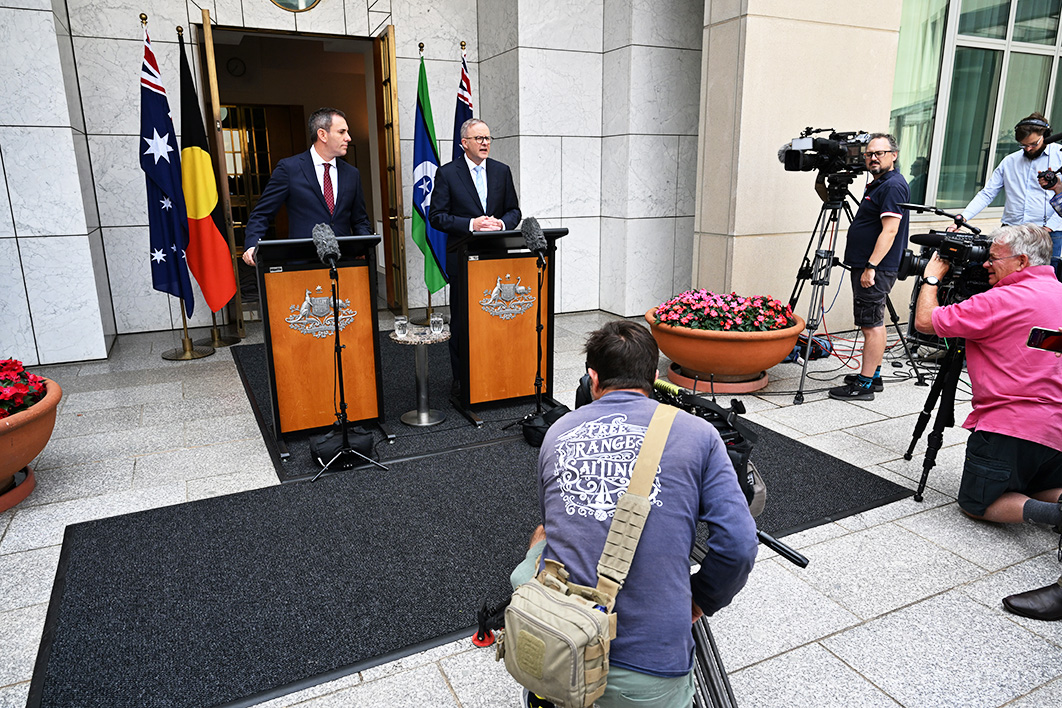
For a brief moment last year Australia’s long-vanished era of full employment seemed have returned. Thanks to a strong recovery from Covid restrictions, the newly elected Albanese government inherited an unemployment rate of 3.9 per cent, the lowest since the economic crisis of the early 1970s. The figure was also close to what is traditionally seen as full employment: the point where the number of unemployed workers and unfilled vacancies are equal. Unemployment at that level essentially reflects the “friction” that occurs as workers move from one job to another.
Unlike any government for many decades, the Labor government explicitly committed itself to full employment. In opposition, Anthony Albanese promised to hold a jobs summit and commission a white paper on full employment. No doubt deliberately, the fact that it would be a “White Paper” called to mind the founding document of postwar Australian prosperity, the 1945 White Paper on Full Employment in Australia.
Commissioned by John Curtin’s wartime Labor government and written by a team led by economist H.C. “Nugget” Coombs, the 1945 paper used John Maynard Keynes’s economic model as the basis for a commitment to use taxes and spending to maintain full employment.
At the same time, the Chifley government turned the Commonwealth Bank into a modern central bank. Having refused to help save the economy during the Great Depression, the bank would now be explicitly focused on maintaining full employment. Coombs was appointed governor, and retained the position after Robert Menzies’s Liberals took government.
Later, still under Menzies, the Reserve Bank Act of 1959 split off the commercial functions of the Commonwealth Bank and created a new Reserve Bank of Australia with three statutory objectives: price stability, full employment and general prosperity.
Changes in monetary policy were also in prospect when Albanese and his colleagues took government last year. The shift to inflation targeting in the early 1990s, implemented using adjustments to central bank lending rates, had put the Reserve Bank in full control of macroeconomic policy. Like other central banks, it reinterpreted full employment to mean the “non-accelerating inflation rate of unemployment,” or NAIRU, a model-based construct derived from the work of Milton Friedman. (Friedman preferred to call this the “natural rate” of unemployment.) Estimates of the NAIRU aren’t stable (they are usually above the actual rate of unemployment), but have recently been near 4 per cent.
Events since the global financial crisis have challenged the belief that inflation targeting can ensure financial and economic stability. For much of the decade after 2008, central bank interest rates were stuck at or near zero in most countries. Australia was heading in the same direction, with the cash rate down to 0.75 per cent, when the pandemic hit. Responding to this and other unexpected developments, the new government commissioned a review of the Reserve Bank.
The stage seemed set for a return to the policies that gave us the postwar Golden Age. But it didn’t take long for the lights to dim. The jobs summit turned into a “jobs and skills summit” dominated by employers complaining about “skills shortages.” It wasn’t so much a shortage of specific skills; rather, employers had come up against the fact that full employment makes it as hard for an employer to fill a vacancy as it is for a worker to find a job.
Then the word “Full” disappeared from the title of the Albanese government’s Employment White Paper, which is still a work in progress. True, maintaining full employment still appears at the head of the list of objectives, but discussion so far suggests it will get short shrift when the white paper actually appears.
When it was released last month, the Reserve Bank review reflected a similar tendency. Most attention was focused on internal restructuring, while the desirability of a higher inflation target and other issues were kicked down the road. Discussion of the full employment objective in the bank’s charter was limited. Most damagingly, the review recommended removing the treasurer’s power to override decisions of the bank via an announcement to parliament. Although it has never been used, the existence of this option was central to the integrated operation of fiscal and monetary policy in the decades before the shift to inflation targeting.
And, finally, we come to the budget. The scene had been set by the report from the government’s new Economic Inclusion Advisory Committee, which recommended a large increase in the poverty-level JobSeeker benefit and a commitment to full employment. Labor treasurer Jim Chalmers immediately signalled that the first of these recommendations would be rejected as both unaffordable and politically unpopular.
Eventually the government was shamed into a modest increase in JobSeeker, but full employment disappeared from the agenda. The budget projected an unemployment rate of 4.5 per cent — exceeding estimates of the NAIRU, let alone any measure of full employment based on actual labour market outcomes (such as requirement that there should be as many vacancies as unemployed workers). During his budget speech Chalmers described the rate as “low by historical standards,” effectively confirming that his benchmark is the last fifty years of failure rather than any notion of full employment. He then returned quickly to the central theme of the government’s policy, the need to reduce inflation.
Even this short period of full employment has had hugely beneficial consequences. Workers who previously have been dismissed as unemployable have suddenly found employers willing to take them on. Remote work has persisted since the lockdowns because employers who demand five-day attendance lose workers and can’t find replacements. Even more radical ideas like the four-day week are gaining traction.
With luck, and full employment will persist a little longer. But if it does, no thanks will be due to this Labor government. •
The post Five minutes of sunshine? appeared first on Inside Story.







